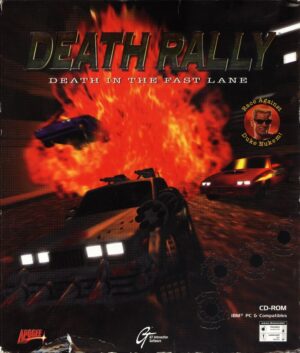Retro Replay Review
Gameplay
Alone in the Dark delivers a tense, resource-driven survival experience by blending first-person precision with third-person situational awareness. Edward Carnby’s eight-episode journey lets you freely switch perspectives on the fly, allowing for immersive firefights up close or tactical planning from a distance. This dynamic camera system shines when manipulating objects—wield a fire extinguisher in first-person to smother flames accurately, then drop into third-person to slam through a barricade.
(HEY YOU!! We hope you enjoy! We try not to run ads. So basically, this is a very expensive hobby running this site. Please consider joining us for updates, forums, and more. Network w/ us to make some cash or friends while retro gaming, and you can win some free retro games for posting. Okay, carry on 👍)
Scarcity of conventional ammunition forces creative problem solving at every turn. Pistols and shotguns are present but limited, nudging players to employ environmental hazards as weapons. Lighting a wooden chair ablaze or luring enemies into an oil slick, then igniting it with a lighter and hairspray, becomes second nature. This push toward improvisation enhances tension and rewards players who examine every nook and cranny for makeshift implements.
Fire itself is both a tool and a threat in the world of Alone in the Dark. Flames spread realistically, engulfing corridors and locking off routes you’ve already passed through. A small spark in an old carpet can turn into a raging inferno if left unchecked, forcing you to decide between risking burns or fleeing to find an extinguisher. This living environment creates emergent gameplay moments that feel unique in each playthrough.
Graphics
The game’s depiction of 1920s-era New York is rife with atmosphere, from dilapidated apartments to Central Park’s twisted darkness. Textures on crumbling brickwork and peeling wallpaper are impressively detailed, making buildings feel genuinely aged. Dynamic lighting casts long, ominous shadows that punctuate every corridor, heightening the horror as the unknown could lurk anywhere just beyond your flashlight’s beam.
Special attention has been paid to the depiction of fire and its effects. Real-time flame propagation and smoke behavior are handled superbly, with embers drifting off-burning surfaces and sparks igniting flammable debris. Watching a wooden desk smolder and collapse under heat adds weight to each environmental interaction, and you’ll find yourself both fearing and craving the power of fire.
Character models and animations are strong, particularly during tense combat encounters. Edward’s movements vary smoothly between cautious stalking and frantic backpedaling, depending on the perspective. Minor clipping issues can occur when toggling cameras mid-action, but such hiccups are minor in a title so focused on mood and immersion.
Story
The narrative kicks off with Edward Carnby awakening in a New York apartment after 83 years, minutes from being gunned down by a mysterious group. Stripped of memory and confronted by his own youthful reflection in the mirror, Carnby’s quest to unravel his identity dovetails with a larger supernatural threat tearing through the city. This hook instantly engages, combining classic detective noir with eldritch horror in a fresh way.
As you progress through the eight episodic chapters—each accessible in order or via the main menu—you uncover pieces of Jeremy Hartwood’s tragic past and Carnby’s true age-defying condition. An old adversary resurfaces, hungry for a powerful stone that may be tied to Carnby’s longevity and the outbreak of malevolent forces. The story steadily unfolds through in-game dialogue, environmental clues, and brief cutscenes that never overstay their welcome.
While the overarching arc remains coherent, the choice to let players tackle episodes non-sequentially can occasionally dull narrative momentum. That said, each chapter brings its own set of discoveries, from journal entries in haunted mansions to cryptic symbols etched into park statues. For fans of investigative horror, piecing together the plot is as rewarding as fending off the horrors it spawns.
Overall Experience
Alone in the Dark stands out by emphasizing ingenuity over brute force. By turning everyday tools and hazards into weapons, the game rewards observation and experimentation. Moments of calm exploration make the sudden onslaught of chittering monstrosities all the more startling, and the looming threat of an unstoppable fire offers a persistent sense of urgency.
The flexible camera system enriches both combat and puzzle-solving, though occasional perspective shifts require split-second timing. The episodic structure encourages replayability, as you might revisit earlier chapters armed with new weapons or insights to unearth hidden secrets. Those seeking a tightly woven narrative may miss a linear flow, but the added freedom enhances variety and pacing.
Overall, Alone in the Dark delivers a compelling blend of survival horror, environmental puzzles, and period detective work. Its rich graphics, cleverly designed fire mechanics, and engaging story make it a must-play for genre enthusiasts and anyone craving a fresh spin on classic horror themes. Whether you’re a longtime fan or a newcomer curious about Carnby’s legacy, this title offers a deeply immersive, memorable trek through a city consumed by darkness.
 Retro Replay Retro Replay gaming reviews, news, emulation, geek stuff and more!
Retro Replay Retro Replay gaming reviews, news, emulation, geek stuff and more!









Reviews
There are no reviews yet.